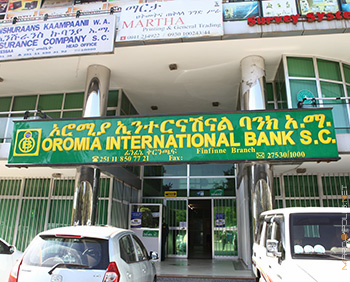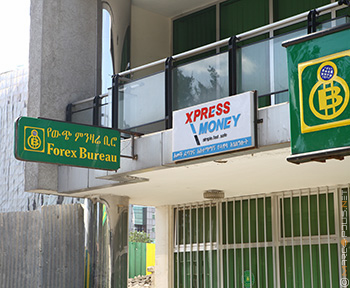Ethiopian banking market remains untapped despite fast growth, says Oromia International Bank
Abie Sano Mehamed, President of Oromia International Bank
While Ethiopian population reaches almost 100 million the size of the banking market lags behind and remains very small – only 19 banks. Oromia International Bank first opened the doors on October 25, 2008 and since then the bank has experienced rapid growth; opening 26 branches in the first 8 months of operations. For the time being, Oromia International Bank remains the fastest growing bank in the history of Ethiopia.
Interview with Abie Sano Mehamed, President of Oromia International Bank

What is your overview of the banking sector in Ethiopia and what is your outlook for 2014 and onward?
The banking sector in Ethiopia is really in the growing stage. You will find that the population of this country is estimated to be close to 100 million but the size of the banks that we have is very small. We only have 19 banks in total and the aggregate branch size of these 19 banks is about 1,700. This number of banks has only been achieved in the last four years and before that there were only about 600 branches. About 1,000 branches have been added into the market in the last three or four years. It is in a fast-growing stage and I’m sure the future will also be good because the market is still untapped.
The stress is coming in because of the gap between the demand and the supply. The demand for resources is very high, both from the customer side and from the bank side. From the bank side, there is growth but the supply is not the same. What I mean by that is that the demand for foreign exchange and import financing is very huge but the supply is very small. There is a huge gap and this is creating a big stress on banks. Again, the supply for financing, even on the domestic side, is also very high because of many infrastructure projects and many factories under construction, but the supply from the bank side cannot keep up with the demand. It is huge pressure. Of course, there is a good opportunity for banks because they can easily sell whatever they have, but because of lack of supply it is creating a problem for the banks.

On the other side, there is huge growth on the bank side. In just the last four years, 1,000 branches have been added to the market, not to mention the number of ATMs installed during this period. These banks require human resources; you cannot create this size of HR within this period and so the lack of enough skilled human resources for operations and even sometimes in the area of leadership is another pressure. There is opportunity for growth and in the bank, the business volume is there, so if there is no problem with the resources then the growth will be excellent because the business is there.
Can you give us a brief history of Oromia International Bank and how it started?
Oromia International Bank has been in operation for just five years. We opened our doors on October 25, 2008 and since then we have been growing quickly. It is a historic bank; I think it is the first bank to open 26 branches in just the first 8 months of operation and in the first year of business. The practice before that was to have only one or two branches, particularly in the first year of operation. But Oromia International Bank has changed that history and has opened 26 branches in only 8 months. Before that, no other bank did this, even within a year of opening. This has changed the history of the country. After we declared this in June 2009, all the banks started to open branches. It was following this that 1,000 branches opened in the last four years, since June 2009. We are pushing the market into new areas and we are also growing. Now we have about 80 branches; it is the fastest growing bank in the history of Ethiopia and it is also growing in assets, business and profitability. I can say it is a successful bank and is growing very quickly.
The population of this country is estimated to be close to 100 million but the size of the banks that we have is very small. We only have 19 banks in total and the aggregate branch size of these 19 banks is about 1,700. This number of banks has only been achieved in the last four years and before that there were only about 600 branches.
What types of services do you provide to your clients here in Ethiopia?
We provide all commercial banking services. We provide deposit services for saving, and credit of different sorts for all sectors, mainly those on which other banks did not focus previously. We also provide trade services for international import and export business and other services like international money transfers, local transfers and other payment services, some advisory services for customers as well, and guarantees.
You are also present in the insurance sector. What type of insurance underwriting do you offer to your clients?
On the international business side, we are assisting in documentary credits. Basically in Ethiopia you are not allowed to finance off – or what you do is only local, so what we do is assisting in documentary credits for opening letter of credits for importing and assisting in payment. For exports, we also provide advice to our customers locally for facilitating their export proceeds. That is all that we do; it is very limited. We don’t go into the stock market or all those things that are not available here.
What is the actual number of Oromia International Bank branches in Ethiopia?
There are 78 branches now. The number of 65 was what it was in June 2013 but now it is 78.
Do you still have a plan to add 40 more branches?
Yes at the end of this fiscal year in June 2014, we will have 106 branches in total.
 Are you active in the mortgage service and how is that part of your business?
Are you active in the mortgage service and how is that part of your business?
We do mortgage business but it is not big enough. The set limit is very low and we don’t have big mortgages in our portfolio; it is a very small part of our business, at less than 3% of our portfolio.
Do you offer your clients any investment products or act as an intermediary in terms of investment products, such as for government bonds or the Renaissance dam project?
That is basically a kind of policy instrument that all the banks engage in, particularly the private banks. We purchased LVVs at the tune of 27% of all the disbursements that we are making. It is now exceeding US $800 million out of our portfolio and that’s growing. We will continue purchasing as long as we disburse. We have to allocate 27% to the purchase of these bonds.
Is that in hard currency?
It is in local currency.
What type of growth have you achieved in the last couple of years and do you see that trend continuing forward?
We hope that it will continue but it might not be at an increasing rate as we have had in the past because at the early stage of an institution, growth is at an increasing rate. We will try to keep our growth pace; naturally there will be a reduction in the rate of growth but the growth will still be there. We hope that we can maintain our growth trend for some time.
The growth of non-performing loans in certain banks has been on the rise. Do you think that will be an opportunity for you to do some acquisitions in the future?
 We don’t have a strategy for acquiring bad loans and we don’t have a policy of acquiring banks either. Banks can join by a merger if they want to. Because of bad loans, there is no such big risk in Ethiopia for considering acquiring the banks. Even though there are bad loans, the size can be managed because we know the size of bad loans as a whole in Ethiopia is not as bad as you would think. There is no such threatening situation for the banking industry as a whole because there is a strong regulatory issue for knowing the bad loans. There are some banks of course that are concerned with this because of their portfolio concentration, but if they re-think and re-distribute their portfolio they can control this. There are no such significant bad loans that push the bank to be acquired by another bank in Ethiopia.
We don’t have a strategy for acquiring bad loans and we don’t have a policy of acquiring banks either. Banks can join by a merger if they want to. Because of bad loans, there is no such big risk in Ethiopia for considering acquiring the banks. Even though there are bad loans, the size can be managed because we know the size of bad loans as a whole in Ethiopia is not as bad as you would think. There is no such threatening situation for the banking industry as a whole because there is a strong regulatory issue for knowing the bad loans. There are some banks of course that are concerned with this because of their portfolio concentration, but if they re-think and re-distribute their portfolio they can control this. There are no such significant bad loans that push the bank to be acquired by another bank in Ethiopia.
What are some of the challenges that you see in the industry moving forward?
Basically the challenges are what I mentioned to you earlier. It is the lack of supply and the big size of the demand. This mismatch is very critical, particularly on the human resource side. We have the interest to grow and to cover the market and to position ourselves, but getting the required quality of expertise to do the job and to maintain our standard of service is a challenge that I see for the future.
There are huge international projects underway and the demand for resources for these infrastructure projects is also huge. There is a risk of pushing or taking away the supply for other parts of the sector and this might create an economic imbalance in the future. I have a fear in that area. This probably can be managed but the resource problem, particularly human resource quality and resource in the skilled resource area, is a big challenge for the banks ahead.
The infrastructure sector, particularly in telecom, is another serious problem for banks because we are heavily dependent on technology. We have a centralized system and when there is any break between our head office and a branch, the bank does not have anything. Every piece of data we have is here at the center and they cannot offer services to our customers. This is a big worry. Currently I have two branches detached from the head office; the data is here. This is a serious problem and I don’t expect it will be solved in the near future because of the large size of the country and the fact there is only company which is dealing with it. It is a government-owned company and it is making money whether it provides the service or not. This is a big challenge for the banks.
Can you give us your vision for the future of the bank?
The future of the banks is a bit mixed; the growth of the country provides a good opportunity for the banks in Ethiopia. Because the size of the banks is very small and the population of the country is very big, there is huge opportunity for selling services to the public. Any commodity you bring in you can sell because the consumer side is big. Increasing the middle class is also an opportunity for the banks to get more business but this opportunity and the strength of the banks will continue until we have to compete with international banks.
In total, the strength of the banks locally in Ethiopia is still not strong enough to compete with international banks. If the country is progressing and is now attempting to be a member of the WTO, the pressure will come in on the banks unless the banks merge to form a solid strong bank. If the number of banks by merger come down to five, they can probably compete with any international bank but with the current size of 19 smaller banks, that might not be a good structure to stand strong in front of international banks. If the door continues to be closed as it now, it will be still profitable for the coming ten to fifteen years, but if the door is opened I think it will be a challenge for many banks to continue to be as profitable as they are now.
FAIR USE POLICY
This material (including media content) may not be published, broadcasted, rewritten, or redistributed. However, linking directly to the page (including the source, i.e. Marcopolis.net) is permitted and encouraged.